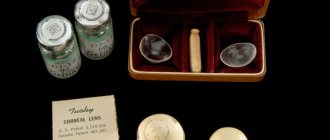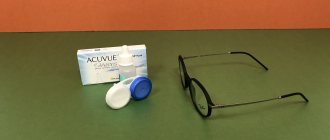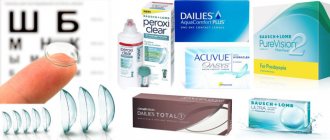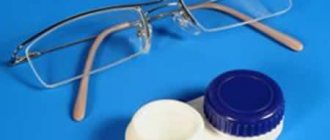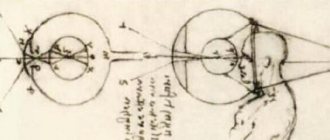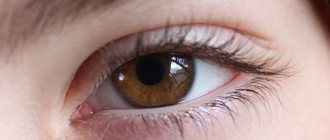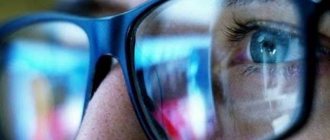Is it possible to wear lenses if you are farsighted?
With the help of contact lenses, even a high degree of hypermetropia (+6 D or more) can be corrected, so the answer to the question posed is completely obvious - it is possible. But the fact is that the selection of these optical devices must be taken with full responsibility, because wearing unsuitable lenses is fraught with a further decrease in near visual acuity, the development of asthenopia (rapid eye fatigue, the feeling of sand poured into them, headaches), as well as the occurrence of complications ( cataracts, glaucoma, inflammatory eye diseases).
Farsightedness refers to refractive errors and is expressed in the fact that light rays passing through the optical media of the eye are focused not on the surface of the retina, as provided by nature, but on a conventional plane behind, sometimes far beyond the boundaries of the eyeball. If the deviation from the norm is insignificant (within 3-5 diopters), it can be compensated by accommodation (change in the curvature of the lens). But with age, this mechanism is also depleted, and then the need arises for surgical, laser or optical vision correction.
Contact lenses for farsightedness have positive diopter values because they are designed to replace a worn lens or an insufficiently convex cornea, bringing the focus of light rays closer to the retina. This is possible due to the collecting optical design.
You need to understand that wearing contact lenses is not a method of treating farsightedness, age-related or congenital, but if you use these products correctly, you can relieve eye strain and slow down the wear of the visual apparatus. Modern SCLs (soft contact lenses) are very comfortable and safe, so they are allowed to be worn not only by adults, but even by children over 8 years old. In addition, there are special lenses for correcting myopia and farsightedness at the same time, which is especially important in the case of presbyopia (“senile vision”).
Video: how to choose the right lenses and whether they can replace glasses:
Causes
People of all ages face this diagnosis. There are a large number of factors that lead to visual impairment. Doctors include common reasons:
- decreased accommodation;
- presence of genetic predisposition;
- eye injuries, presence of a foreign body;
- prolonged and constant stress on the eyes;
- failure to comply with hygiene rules;
- infectious and viral diseases.
In some cases, predisposing factors may be vitamin deficiency, disruption of the vascular system, or diabetes mellitus. It is important to consider that genetic predisposition cannot be treated. With the help of therapy, you can only slow down the development of the pathological process.
Vitamin deficiency can be compensated for. But it’s impossible to fight genetics. In this case, the patient should be under the supervision of an ophthalmologist at all times. If vision decreases, correction is carried out. But this is possible only after a full diagnosis and history taking. If there are people in the family who suffer from myopia, you should inform your doctor about this.
In medical practice, there are also more severe cases, which are accompanied not only by myopia in a mild form. Over time, this pathology may be joined by cataracts, glaucoma, retinal detachment and degeneration. These disorders may have a disappointing prognosis.
Especially if they are not detected in a timely manner. They lead to the development of moderate and severe myopia.
It is impossible to diagnose yourself. Many ophthalmic diseases have similar symptoms. Therefore, a person can make a mistake and harm his own health. Only an ophthalmologist can determine the cause and an accurate diagnosis after a full examination.
Advantages and disadvantages of contact lenses
Lenses are better than glasses, if only because they cope with their main task much better. They not only provide high clarity of vision, but also maintain a good lateral view without causing distortion or narrowing the field of view.
There are other obvious benefits of contact lenses for farsightedness:
- They do not need to be carried around in a case, wiped, taken off and put on throughout the day;
- They are very effective and can correct even severe hypermetropia;
- They can be considered comfortable and completely safe when used correctly, because the soft structure is not capable of injuring the eyes;
- They are absolutely invisible, do not spoil your appearance and can even improve it if you prefer a colored version;
- They can be left on during active sports, thereby maintaining clarity of vision even in extreme conditions;
- They do not glare or fog up, unlike glasses.
The disadvantages of SCL include the following points:
- Quite a long adaptation period. Moreover, some people, especially very young and elderly patients, refuse to wear contact lenses for farsightedness because they cannot get used to the sensation of a foreign body in the eye;
- The relatively high cost, combined with the need for frequent replacement, can make this type of optical vision correction simply inaccessible to some categories of citizens;
- The need for very careful adherence to the rules of hygiene, storage and care of products;
- The likelihood of developing complications (conjunctivitis, blepharitis, keratitis), especially if the above rules are neglected.
Contraindications to wearing contact lenses for farsightedness and any other vision defects are as follows:
- Infectious and inflammatory eye diseases;
- Pathologies of the lacrimal glands and disturbances in the composition of the tear fluid;
- “Dry eye” syndrome or vice versa, increased tearfulness;
- Bronchial asthma, allergies, vasomotor rhinitis;
- Injuries, functional and degenerative-dystrophic changes in the eyes (glaucoma, cataracts, dislocation and subluxation of the lens, severe strabismus, drooping or incomplete closure of the eyelids (lagophthalmos).
Video from the program “Live Healthy!” Glasses or contacts?
Whim or protection - anti-glare glasses for computers
Working at a computer involves constant eye strain. In 25% of cases, frequent exposure to a monitor develops chronic fatigue of the visual organs, and increases the risk of developing various ophthalmological diseases that require treatment.
Special anti-glare glasses for computers can prevent the appearance of unpleasant and painful sensations, uncontrollable tearing, pain and other similar symptoms.
Fashion accessory or necessity
If the benefits of conventional glasses for vision correction are beyond doubt, then the appropriateness of anti-reflective optics may raise questions. Why are anti-glare glasses needed, what function do they perform, and how justified is their purchase?
Such optics relieve symptoms of the negative influence of electromagnetic radiation from a computer monitor and television screen on the eyes. In particular, these are:
- Eye fatigue, signs of general fatigue, causing decreased performance.
- Feeling of dryness and sand in the eyes.
- Inappropriate reaction to light (desire to close your eyes, turn away from the light, be in the dark);
- Incorrect perception of colors and shades (inability to distinguish and/or incorrect recognition of colors).
- Decreased sensitivity of eye receptors.
Anti-glare computer glasses are especially recommended for programmers, writers, graphic designers and representatives of other professions whose main activity requires spending many hours at the computer. It also effectively relieves eye strain in vehicle drivers.
Read the article on how Leber congenital amaurosis is diagnosed and treated.
Working on a PC is dangerous for your eyesight
Find out what high amblyopia is in children here.
How they work
Special computer optics act as a kind of filter that prevents the effects of light and radiation on the eyes. Lenses are almost never colorless.
To cut off the blue-violet color spectrum and preserve the clarity and color rendition of images without unnecessary stress, they are coated with a protective layer of yellow, green or violet. Additionally, state-of-the-art optics are coated with an anti-reflective layer, which is necessary to neutralize random glare.
However, there are nuances to using such a “filter”:
- Since getting used to it occurs gradually, at first it is recommended to wear anti-glare glasses (AO) for no more than 3 hours a day.
- You cannot use AO unless necessary: wearing it outside can lead to absolute isolation of the eye from the sun and provoke “dry eye” syndrome, i.e. inability to produce tears and vulnerability to light.
When purchasing protective anti-reflective optics with diopters, you need to choose a product that is 2 diopters weaker.
Do not lose sight of the details - amblyopia in adults is treated.
Special optical “device”
A disease that requires close attention is retinal angiopathy in a child.
Varieties
You can purchase the following types of anti-glare computer glasses at the optical shop:
- With monofocal lenses - intended for people with normal vision. This is a standard optic that allows you to cover a wide field of view.
- With bifocal lenses, i.e. having dual focusing. The optical zones in them are divided in such a way that one part is adapted for perception of the image at close range, the other for focusing on the monitor. In this case, objects in the distance will not be clear.
- With progressive lenses - divided into segments that have no visible border. They allow you to quickly “switch” your vision from objects outside the monitor to the image on the computer without feeling discomfort. 3 segments are adapted for viewing at a long distance (upper part), for perceiving the “picture” on the monitor as a whole (middle wide part) and for focusing at a close distance (small, lower segment).
Models with progressive lenses are considered the most practical, because... allow you to view objects and images equally comfortably at any distance.
Instructions for using Acyclovir eye ointment are presented here. An important symptom for diagnosing serious diseases is retinal vascular angiopathy.
Lenses
Is it possible to do without doctors? — Treatment of astigmatism at home.
How to choose
Anti-glare glasses to prevent fatigue, tearing, dryness and other painful sensations in the eye area cannot be chosen solely on the basis of low cost, reviews or recommendations from friends.
Otherwise, you can harm your visual organs or simply not achieve your goals. When choosing a joint stock company, we are guided by:
- Features of visual receptors (this is important when selecting lenses, for example, glasses with monofocal lenses are not suitable for myopia or farsightedness, since the “picture” may be blurred).
- Individually shaped eye sockets.
- The quality of the product (when buying a cheap product, it is easy to “run into” a fake or defective product, also practicality and convenience should take precedence over a fashionable frame design, etc.).
Anti-reflective optics are purchased via the Internet, through advertisements and in dubious stores. Such a product may cause more harm than good and may not meet the buyer's expectations.
The types and causes of anisocoria are described here.
For women
The secret weapon in the fight for a healthy look is antibacterial eye drops.
The best models of glasses for computers
Among the best producers, along with Germany, Japan and Switzerland, Russia can also be distinguished.
HOYA, Japan
A recognized leader in the ranking of manufacturers of polymer spectacle lenses with varying degrees of refraction. This is the only company that carries out a full technological cycle of developing items that correct vision and protect against ultraviolet rays, including the application of coatings of its own design.
The advantages of Hoya products include water-, grease- and dirt-repellent, as well as antistatic properties. The BlueControl coating neutralizes blue spectrum colors.
Unpleasant sensations while wearing anti-glare glasses may be due to a defect in the product or incorrect ophthalmological parameters. In this case, it is not advisable to continue using them.
HOYA
How to choose anti-glare glasses for drivers is described in detail in the article.
SP Glasses (Fedorov glasses), Russia
They prevent the negative effects of electromagnetic radiation, reduce eye fatigue from prolonged stay in a room with fluorescent lamps and tearing caused by working at a computer. Plastic lenses without diopters, thin. They have a yellow tint that blocks bright light, which creates a relaxing effect.
The frame of the glasses is made of lightweight plastic. The kit includes a protective case with a cord and a special lens cleaning cloth. “Minus” is ordinary cardboard packaging, which is subject to a high risk of damage when sending the goods by mail.
SP Glasses
What types of contact lenses are there for farsightedness?
Many people are interested in what they need to pay attention to when selecting such products? After all, after undergoing an examination by an ophthalmologist, you will only know what refractive power in diopters they should have, as well as what lens design is best suited for correcting your specific visual impairment. But besides these aspects, there are others that directly affect the convenience, quality and cost of products. Let us consider the most important criteria for choosing an SCL in more detail.
Materials and characteristics
Currently, hydrogel and silicone hydrogel SCLs are the most widely used. The second option is preferable because it offers maximum safety and comfort. Several years ago, contact lenses made of water-gradient material appeared on the shelves of optical stores, which are superior to their old counterparts in all key parameters, but are much more expensive.
When choosing lenses for farsightedness, it is necessary to take into account such characteristics as oxygen permeability, water content, radius of curvature, tensile strength, optical power, design and purpose.
In addition to soft products, there are also hard contact lenses (RCLs). They are made from polymethyl methacrylate and organosilicon polymer, but are used extremely rarely - only about 10% of visual impairments are corrected using LCDs. We will talk about this in more detail below when we discuss night lenses and the orthokeratology technique.
Mode and duration of wearing
As for the service life of SCLs, based on this criterion they are all divided into four categories:
- One-day;
- Two weeks;
- One-month;
- Quarterly.
We emphasize that we are not talking about continuous wearing. Even a product intended for long-term use (3 months) is usually worn only during the day, and removed at night and stored in a special solution. In any case, after the expiration date, the lenses must be disposed of, since they lose their functionality and can even cause harm to the eyes.
The operation mode of MCL is as follows:
- Daytime – we described it above;
- Flexible – allows continuous stay in the same lenses for 2-3 days;
- Long-lasting – the product can be left in place for a whole week or more.
Even if the manufacturer assures that it is completely safe to wear their contact lenses for a long time, ophthalmologists still strongly recommend removing contact lenses at night and giving your eyes rest at least while you sleep.
Practice shows that people who regularly use products with prolonged use more often develop inflammatory complications, and sometimes even experience a rapid deterioration in visual acuity. Therefore, think, is it worth risking your health because of laziness? In any case, keep in mind that only silicone hydrogel SCLs, that is, products of the “latest generations,” are suitable for long-term wear.
Video: complications when wearing contact lenses:
Treatment
Every person who is faced with such a problem should understand that this is not a death sentence. This pathology can be corrected. Therefore, in this way, vision can be restored. Basically, doctors prescribe patients to wear glasses or contact lenses to help correct their vision. But it is important to consider that it is impossible to return original visual acuity.
It can be completely restored only with the help of medical intervention. In this case, laser coagulation and lens replacement are performed. Wearing optical products is not mandatory. But at the moment this is one of the simple and affordable methods of vision correction. Glasses will help you see distant objects clearly. They also protect against various complications. When reading books, this is not necessary, since a person already sees normally.
Rules for selecting contact lenses
If you are farsighted, only a qualified doctor can determine which lenses you need. He will also give practical advice regarding the type and mode of use of such products. Purchasing SCLs on your own without first consulting an ophthalmologist is almost certainly a waste of money, and sometimes the cause of complications.
To correctly select lenses for farsightedness, the following diagnostic procedures may be necessary:
- Visometry;
- Refractometry;
- Ophthalmoscopy;
- Accomodometry;
- Checking lateral vision and binocular functions of the eyes.
Here are the main criteria that need to be taken into account when choosing an SCL:
- Optical power
– this indicator is measured in diopters and characterizes the degree of hypermetropia in a particular patient;
- Radius of curvature
– the structure of the eyeballs may vary between people, but most patients are suitable for lenses with a standard radius of 8.6 mm;
- Water content
– the higher it is, the softer and more comfortable the product, however, harder specimens provide better clarity of vision;
- Oxygen permeability
– the risk of complications depends on it: “breathing” SCLs are safer in this regard;
- Tensile strength
– directly affects the service life of each individual pair of contact lenses.
How to use contact lenses?
Before putting the SCL on your eyes, you need to wash your face and hands with soap and water, then dry thoroughly. Any optics manufacturer must include an instruction manual with its product, which contains a schematic representation of the order of actions that you have to perform. Follow the prompts and in a few seconds the lenses will be in place.
In the evening, before going to bed, the SCL should be carefully removed, also based on the attached manual, and stored in a special solution. It has a standard composition and is sold in all major optical stores. However, it is worth clarifying which drug is best suited for your type of SCL. Both the solution and the plastic lens storage container itself must be replaced every 3-6 months.
If, while wearing contact lenses, you find signs of acute respiratory viral infection, flu, or bacterial infection of the upper respiratory tract, immediately remove the contact lenses and do not resume using them until you have completely recovered!
Otherwise, you will very easily get an infection in your eyes. It is unnecessary to talk about the need to contact an ophthalmologist in case of existing symptoms of eye inflammation - this goes without saying. In addition, you should be alert to any manifestations of discomfort directly or indirectly associated with MCL, ranging from lacrimation to headaches. Perhaps the lenses do not suit you or no longer suit you. An urgent visit to an ophthalmologist is required by situations such as sudden progressive deterioration of vision, pain and swelling in the eyeballs, and a sharp worsening of asthenopic syndrome.
Contraindications for wearing lenses
You should not use lenses if a person has:
- you are allergic to the material from which the lens is made or to solutions for their treatment;
- there are inflammatory diseases of the eyelid (blepharitis) or conjunctiva (conjunctivitis);
- drooping of the upper eyelid (ptosis);
- tuberculosis;
— AIDS;
— there is dryness of the cornea;
- increased tearfulness;
- Use with caution in diabetes mellitus.
It is necessary to give up contact lenses for a while and switch to vision correction with glasses during colds. During this period, the immune system weakens and the mucous membrane of the eyes dries out. As a result, the use of lenses can lead to eye injury or infection.
Delayed allergies may occur; in this case, you should also stop using lenses, at least until the symptoms disappear and the cause of its occurrence is determined. You can resume their use only after consulting your doctor. If necessary, you should replace the lenses with similar ones, but made of a different material, or change the disinfectant solutions.
Lenses for age-related farsightedness
Elderly people are most concerned about the question: are there lenses to correct presbyopia and related visual impairments, and what is better - to purchase suitable glasses for a long time or regularly spend money on purchasing SCLs?
As for the functionality of modern contact lenses, they are in no way inferior to glasses, and in some aspects even surpass them. For example, if we are talking about astigmatism against the background of hypermetropia. SCLs also cope well with such a common diagnosis among pensioners as myopia and farsightedness at the same time. Let's look at how they do this.
So, presbyopia is corrected using the following types of contact lenses:
Bifocal.
Otherwise called variables. These are the simplest of all SCLs designed to correct age-related vision pathologies. Such lenses have two optical zones: the upper one for distance and the lower one for near. The disadvantages of bifocal SCLs include too sharp a transition, the lack of a segment for clear visualization of mid-distance objects, and a narrowing of the field of view. This is why many older people cannot get used to wearing such devices.
Multifocal.
This is an improved version of previous SCLs. In addition to the optical zones for near and far vision, there is a third, “middle” zone located between them. Adaptation to such products is usually easier, but it is also not always possible to clearly see objects on the side - instead of squinting, you have to turn your head in the right direction. The disadvantages of multifocal SCLs, of course, also include their high cost.
Spherical.
Such contact lenses are used to correct age-related farsightedness using the monovision method. The doctor determines which eye of the patient has better near vision and which has better distance vision. Then a lens is selected for each eye that can provide respectively clear near and far vision. When the human nervous system adapts to different SCLs, the brain will choose which eye to look in a given situation. The downside is that products of this type are not suitable for drivers, since they cannot guarantee full binocular vision.
Aspherical.
Otherwise called progressive. They are made strictly individually, to order. The central optical zone of these lenses allows you to see well up close, and the peripheral zone allows you to see well at a distance. Moreover, the transition between them is smooth. This design takes into account the natural mechanism of constriction and dilation of the pupil. After all, when we look at nearby objects, our pupil narrows, and when we look into the distance, it expands. Aspherical MCLs are the most advanced and are capable of providing even high-quality lateral visibility. The only disadvantages are the high price and a rather long period of adaptation.
Concentric.
Otherwise called circular and, in fact, are a modification of bifocal SCLs, with the only difference being that the optical zones for near and far vision are concentric circles alternating 4-5 times. In this case, in the center of one lens there is an area “for near”, and in the center so that, as in the case of spherical SCLs, the brain itself chooses the “dominant” eye depending on the situation. Such products are not easy to get used to, and they are also not suitable for driving.
How does a person with minus 2 vision see?
A person with vision of -2 sees distant objects unclearly and blurry. People who have experienced the development of myopia can accurately say this. The main reason for panic is the fear that vision will deteriorate significantly over time. But this should not be a reason to expect bad news. With such symptoms, it is worth undergoing a full examination. It is difficult to determine how a child sees with such vision. Therefore, parents should do preventive examinations for their child at least 2 times a year.
This picture shows how a person with myopia sees. With normal vision, a person clearly sees objects located in the distance.
Glasses significantly help improve vision, but do not restore primary sharpness. This can only be achieved through surgery.
Doctors often use tests to diagnose myopia. Special tables can also be used. Usually the patient does not distinguish letters at a distance of 1.5-2 meters. This significantly reduces the quality of life.
The following recommendations will help determine vision with these indicators:
- Step back about two meters and observe that small inscriptions are difficult to see.
- It's hard to see small objects. This makes everyday life difficult because a person cannot choose groceries at the store or go to the movies.
- The student will only be able to make out what is written on the board the third time. During the medical examination, such students are given the necessary mark, so they are seated at the first desks.
- In the dark and in the evening, it may be difficult for a person to cross the road. If you have myopia, it is difficult to determine the distance of cars.
With minus 2 vision, a person can write normally, do embroidery and handicrafts, and read. With sufficient lighting it is very easy to navigate the space. At the same time, in order to avoid a decrease in visual acuity, it is necessary to alternate the loads with proper rest. Exercises, special gymnastics and self-massage will help with this.
Toric lenses for farsightedness and astigmatism
Astigmatism
- a very complex refractive error, which is characterized by the presence of several focusing points of refracted light rays on the retina or even a focus in the form of a line, figure eight, or irregular figure. Often this pathology is combined with other defects, including hypermetropia. So, there are lenses for farsightedness that can correct astigmatism at the same time, and they work better than glasses, because they are adjacent directly to the cornea, while the glasses of glasses are removed from the eyeballs by about 12 millimeters, and this distance has a bad effect on efficiency of optical correction.
Such devices are called toric contact lenses (TCLs), are made from the same modern materials as conventional SCLs, and have the same advantages: convenience, safety, clarity of visualization. They can also be either transparent or colored. Only the design differs - the TCL is spherocylindrical in shape, that is, one lens has two optical powers at the same time. The first value is responsible for correcting astigmatism along the desired meridian, and the second is for correcting the accompanying pathology of refraction, in this case, farsightedness.
The selection of toric contact lenses requires an in-depth examination by an ophthalmologist. Wearing such products is indicated for astigmatism of 0.75 diopters and above.
Myopia
The projection of what is seen during myopia is displayed not on the retina, but on the plane in front of it. At the same time, a person sees well at a close distance, but distant objects have blurred contours. Constant staring leads to headaches and fatigue.
We recommend reading: Low myopia
Moderate myopia
High myopia
Myopia is characterized by 3 stages:
- Up to 3 diopters.
- From 3.25 to 6 diopters.
- From 6 diopters.
For this vision defect, optics with negative diopters are used. By using lenses at the initial stage, you can completely restore your vision.
